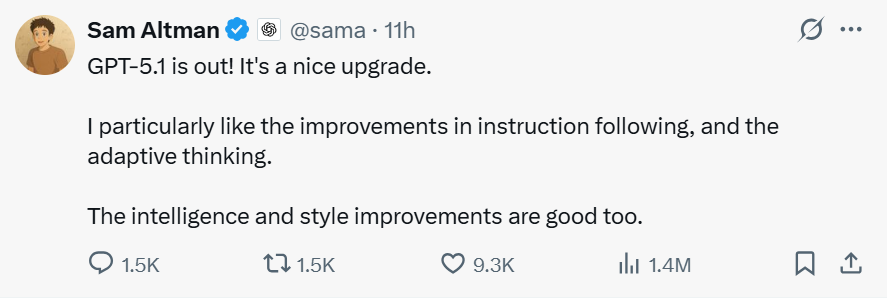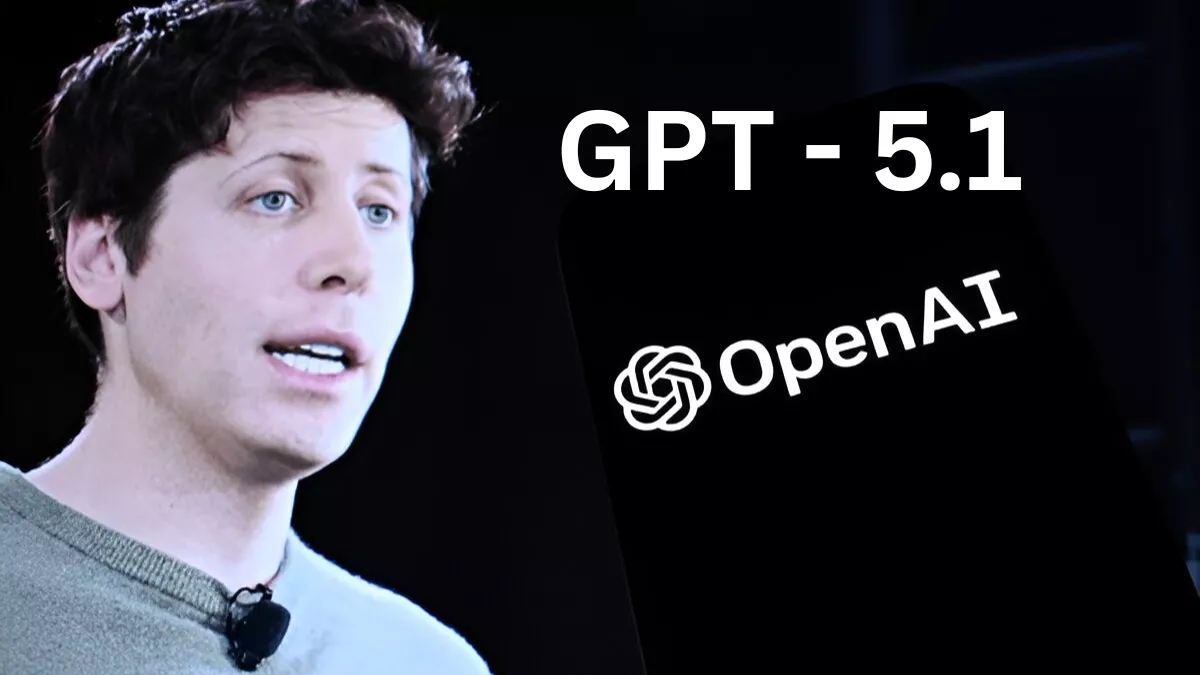OpenAI releases GPT-5.1 on November 12, 2025, featuring Instant mode for faster conversations, Thinking mode for complex queries, and eight personality presets. Paid subscribers get access first, API coming soon.
Key Highlights
- OpenAI released GPT-5.1 on November 12, 2025, with two distinct models: Instant mode for everyday conversations and Thinking mode for complex problem-solving
- Paid ChatGPT subscribers on Plus, Pro, Go, and Business plans get immediate access through a gradual rollout
- Eight personality presets now available: Professional, Candid, Quirky, Friendly, Efficient, Default, Cynical, and Nerdy
- API access for developers coming shortly after consumer launch
- Improved instruction-following, warmer conversational tone, and adaptive reasoning capabilities
- Better performance on math benchmarks (AIME 2025) and coding challenges (Codeforces)
- CEO Sam Altman calls it a nice upgrade, though some critics view it as incremental
- Enterprise and Education plan users receive seven-day early access before it becomes default
What Makes GPT-5.1 Instant Different from Previous Versions
GPT-5.1 Instant serves as the default model for most ChatGPT users. OpenAI designed it to sound warmer and more conversational than GPT-5. The company claims it follows instructions more accurately and responds with a natural tone that feels less robotic. One standout feature is adaptive reasoning, which lets the model decide when to pause and think before answering difficult questions. This helps deliver thorough responses while maintaining quick reply times for simpler queries.
During internal testing, users reported being surprised by the model’s playfulness while still receiving clear and useful answers. The improved instruction-following means ChatGPT now better addresses what you actually ask, reducing irrelevant or incomplete responses. This makes the model more reliable for structured tasks like research assistance, education, and coding support.
How Does GPT-5.1 Thinking Handle Complex Questions
GPT-5.1 Thinking targets users who need advanced reasoning capabilities. This model adjusts its processing time based on question complexity. It speeds through simple tasks but dedicates more computational power to challenging problems. OpenAI reports that Thinking uses fewer tokens on easy questions compared to GPT-5, improving both speed and efficiency.
OpenAI CEO Sam Altman also shared the news on X (formerly Twitter), calling GPT-5.1 “faster, smarter, and more natural than ever — it feels like talking to a real person.”

The model now explains technical concepts with less jargon and fewer undefined terms. This makes complex information more approachable for general users. Benchmarks show improvements in mathematical problem-solving, with better scores on the AIME 2025 competition. Coding performance also increased, with higher accuracy rates on Codeforces challenges and better handling of edge cases.
Can You Customize ChatGPT’s Personality and Tone
OpenAI expanded personalization options with eight preset personality modes. Users can switch between Professional for formal communications, Candid for straightforward responses, or Quirky for more playful interactions. The system also includes fine-tuning sliders that control warmth, conciseness, and emoji usage. These adjustments take effect instantly across all conversations without needing to start new chats.
ChatGPT can now proactively suggest tone changes during conversations. If you ask for a specific style, the system offers to update your preferences automatically. This level of customization aims to make AI interactions feel more natural and aligned with individual communication preferences.
When Will GPT-5.1 Be Available Through the API
OpenAI plans to release API access for developers shortly after the consumer rollout. This will let developers integrate GPT-5.1 capabilities into their applications and services. The API will support both Instant and Thinking modes, giving developers flexibility to choose the right model for their specific use cases. Token-based authentication will handle security, with support for agentic workflows and tool calls.
Enterprise and Education plan subscribers receive a seven-day early access period before GPT-5.1 becomes their default model. GPT-5 will remain available in the legacy models dropdown for three months, giving organizations time to transition their systems. This staged approach helps OpenAI maintain performance stability as millions of users switch to the new version.
What Are Critics Saying About the GPT-5.1 Update
Some technology observers view GPT-5.1 as an incremental improvement rather than a revolutionary leap. The update focuses on refining existing capabilities instead of introducing groundbreaking features. This approach reflects OpenAI’s shift toward consistent user experiences over headline-grabbing model size increases. After GPT-5 received mixed reviews due to its router system causing confusion, the company appears to be prioritizing reliability and transparency.
Industry analysts note that OpenAI faces growing competition from models like Google’s Gemini. The emphasis on warmth, personality, and better instruction-following suggests OpenAI is responding to user feedback that ChatGPT sometimes lacked emotional nuance despite its technical power. Whether these improvements give OpenAI a competitive edge remains to be seen as rival AI companies continue releasing their own advanced models.
How Does GPT-5.1 Compare to Competing AI Models
GPT-5.1 enters a crowded market where Google’s Gemini and other large language models compete for developer attention and consumer adoption. OpenAI positions this release as a step forward in both capability and usability. The company highlights improvements in math, coding, and general intelligence tests like MMLU. These benchmarks show GPT-5.1 handles algorithmic problems more efficiently and demonstrates broader knowledge across diverse topics.
The model’s adaptive reasoning sets it apart by dynamically adjusting computational effort based on query difficulty. This optimization helps balance speed and accuracy better than fixed-reasoning approaches. However, the real test will come as developers and consumers compare GPT-5.1’s real-world performance against competing models in everyday applications.


